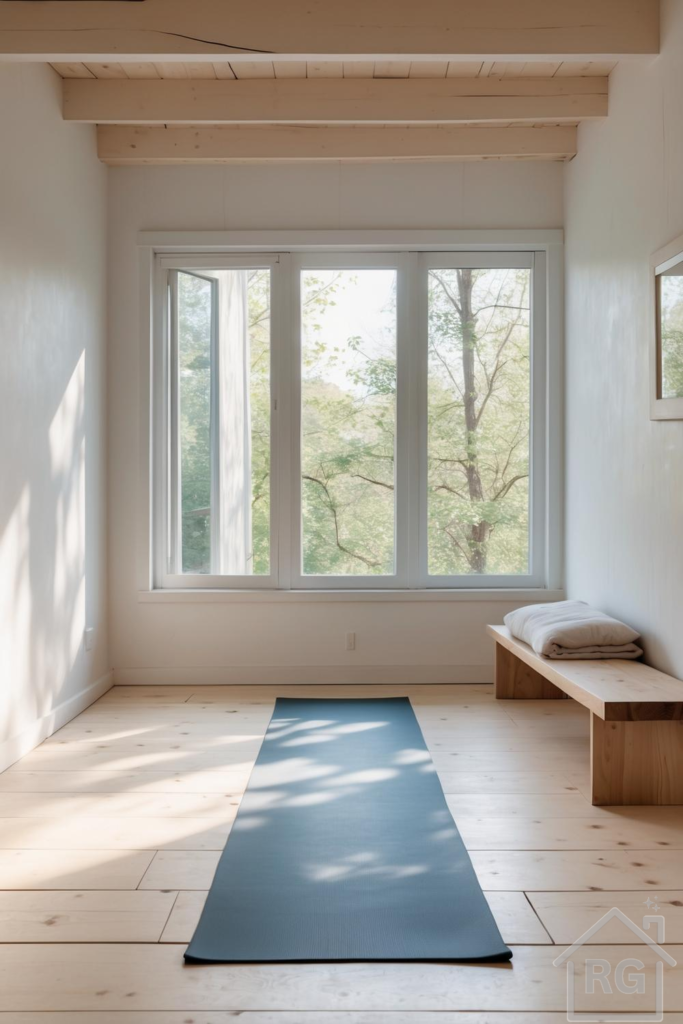
Embracing Tranquility: Crafting Your Personal Yoga Sanctuary
In our fast-paced world, finding moments of peace and stillness is more crucial than ever. A dedicated space for mindfulness practices, such as yoga or meditation, can profoundly impact your well-being.
Imagine stepping into a room that instantly calms your senses, a place where the outside world fades, and your inner journey begins. The image before us perfectly encapsulates this ideal: a serene, light-filled room designed for quiet contemplation and movement. It’s a testament to the power of thoughtful design in fostering a sense of calm and connection, inviting you to slow down and breathe.
The Essence of Serenity: Deconstructing the Design Elements
This minimalist yoga room achieves its profound sense of peace through a harmonious blend of natural elements, a restrained color palette, and an unwavering focus on functionality. Every detail, from the expansive windows to the choice of flooring, contributes to its tranquil atmosphere. Let’s break down the key components that make this space so inviting and conducive to inner peace:
1. The Power of Natural Light and Verdant Views
The expansive, multi-pane window is arguably the room’s most striking feature, acting as a portal to the natural world outside. It invites an abundance of soft, diffused natural light to flood the space, creating an airy and uplifting ambiance.
This deep connection to the outdoors is not merely aesthetic; it’s vital for well-being. The lush green foliage visible through the panes not only provides a soothing, ever-changing backdrop but also brings the calming, revitalizing energy of nature directly into the room. Natural light is known to boost mood, improve focus, and regulate circadian rhythms, creating a more invigorating yet profoundly peaceful environment for practice.
The sheer, light curtain on one side offers a delicate touch, softening the light further and providing a hint of privacy without ever obstructing the magnificent view, allowing the room to feel truly integrated with its surroundings.
2. A Calming Color Palette: White, Warm Wood, and Deep Teal
The room’s color scheme is intentionally simple, yet incredibly effective in its ability to soothe and ground. The walls are painted in a crisp, clean white, a shade that reflects light beautifully, enhancing the sense of spaciousness and purity. This neutral base acts as a perfect canvas, allowing the other elements to stand out without overwhelming the senses or creating visual noise.
Complementing the white is the rich, inviting tone of light wood, prominently featured in the wide plank flooring, the robust exposed ceiling beams, and the sturdy, unadorned bench. This natural wood introduces an organic, grounding element, evoking a sense of warmth, stability, and an undeniable connection to the earth.
The single, deliberate pop of color comes from the deep teal or muted blue yoga mat, a shade often associated with tranquility, depth, introspection, and the calming vastness of water. This subtle yet impactful accent provides a gentle focal point, guiding the eye without disrupting the overall calm and balance of the space.
3. Minimalism as a Guiding Design Philosophy
One of the most powerful aspects of this room is its unwavering commitment to minimalism. There’s nothing superfluous here; every item serves a clear purpose, contributing both to the room’s functionality and its serene aesthetic.
The absence of clutter is paramount in creating a space truly conducive to focus and inner peace. A clear, uncluttered environment helps to clear the mind, reducing mental distractions and allowing for deeper concentration and presence during practice.
This intentional simplicity highlights the inherent beauty of the natural materials, the play of light and shadow, and the pure form of the space itself. It encourages a sense of spaciousness, both physically and mentally.
4. The Tactile Beauty of Natural Materials and Textures
The choice of materials is deliberate and contributes significantly to the room’s overall sensory experience. The wide, light wooden floorboards offer a stable, warm, and inviting surface for yoga practice, their natural grain and subtle imperfections adding a layer of authentic texture and character.
The exposed wooden beams overhead echo the flooring, creating a cohesive and rustic-chic feel that speaks to honest craftsmanship. The simple, solid wooden bench provides a practical spot for props, a water bottle, or a moment of quiet rest, its robust form grounding the space.
Even the soft, light-colored throw blanket draped casually over the bench adds a touch of inviting texture, hinting at comfort, warmth, and relaxation, inviting you to linger and unwind.
5. Functional Simplicity: Thoughtful Furniture and Features
Beyond its striking aesthetics, the room is meticulously designed for practical use and ease of movement. The large window ensures not only ample light but also crucial ventilation, which is vital for a comfortable and refreshing practice.
The wooden bench, while deceptively simple, is a versatile piece, offering a convenient place to store a blanket, a water bottle, or even to sit and meditate before or after a session. The yoga mat itself, a central and essential element, is clearly positioned, inviting immediate engagement with the practice.
The entire design prioritizes ease of movement, a clear path for flow, and an unobstructed area for various postures, which are all essential considerations in a dedicated yoga space. There are no obstacles, only invitations to move freely.
Crafting Your Own Serene Sanctuary: Practical Tips for a Mindful Home
Inspired by this tranquil space, here’s a comprehensive guide on how you can transform a corner of your home, a spare room, or even a quiet nook into your very own personal haven for mindfulness, movement, and meditation:
1. Declutter and Simplify Ruthlessly
Before anything else, embark on a thorough decluttering mission. A minimalist approach is absolutely key to creating a truly serene environment. Remove any unnecessary items, distractions, or anything that doesn’t serve a clear purpose or bring you joy in this specific space.
The goal is to create a clean slate, a visual and mental emptiness that allows for clarity and focus. Think about what truly serves your practice and discard, donate, or relocate anything that doesn’t align with that intention. Less truly is more in a mindful space.
2. Embrace a Calming and Cohesive Color Palette
Opt for light, neutral colors for walls and large surfaces. Soft whites, gentle creams, very pale greys, or even muted earthy tones provide an excellent, expansive foundation. These colors reflect light beautifully and create a sense of openness.
Introduce warmth and depth with natural wood tones through furniture or flooring. For subtle accents, choose calming blues, greens, or soft earthy browns. These colors can be incorporated through accessories like your yoga mat, meditation cushions, small decorative items, or even a piece of art.
3. Maximize Natural Light and Connect with Nature
If possible, choose a room or area within your home that receives abundant natural light. Natural light is a powerful mood enhancer and energy booster. Keep window treatments minimal – think sheer curtains that diffuse light gently, or blinds that can be easily opened to let the light stream in.
Position your practice area to benefit from the sun’s gentle glow, especially during morning or late afternoon hours. If you don’t have a direct view of nature, consider adding a large, calming landscape print or a mirror to reflect light and create the illusion of more space and openness.
4. Incorporate Natural Elements and Textures
Bring the outdoors in to foster a deeper connection to the earth. Use natural materials like solid wood, bamboo, linen, organic cotton, and smooth stone. These materials not only look beautiful but also feel authentic and grounding.
Consider adding a few carefully chosen plants (if they don’t clutter the space) to enhance the connection to nature, improve air quality, and add a touch of vibrant life. Even a simple, sculptural branch, a bowl of smooth river stones, or a natural fiber rug can add an organic, tactile touch that enriches the environment.
5. Choose Functional and Minimalist Furniture
Select only essential furniture pieces that serve a clear purpose and have clean, uncluttered lines. A small bench, a low shelf, or a simple, aesthetically pleasing storage basket can hold your yoga props, blankets, water bottle, or meditation cushions.
Look for pieces with natural finishes that blend seamlessly into the serene aesthetic. Avoid bulky or ornate furniture that can make the space feel heavy or visually busy. The goal is to create an open floor plan that allows for free movement.
6. Layer Textures Thoughtfully for Sensory Richness
While the color palette is simple, texture adds immense depth, warmth, and sensory richness to the room. Think about a soft wool or linen throw draped over your bench, a textured, high-quality yoga mat that feels good underfoot, or the natural grain of wooden floors and furniture.
These subtle tactile elements enhance the sensory experience of the room, making it feel more inviting and comfortable without adding visual clutter. Consider a natural fiber rug for added warmth and cushioning, especially if your floors are cold.
7. Consider Sensory Details Beyond Sight
A truly serene space engages all senses, not just sight. Think holistically about the atmosphere you want to create:
- Sound: Minimize external noise as much as possible. Consider sound-dampening panels if noise is an issue, or use a small water feature for gentle ambient sound. Calming instrumental music, nature sounds, or even the gentle chime of a wind chime can enhance the auditory experience.
- Scent: Use essential oil diffusers with calming, natural scents like lavender, frankincense, sandalwood, or cedarwood. These can help set a peaceful mood and aid in relaxation. Avoid overpowering artificial fragrances that can be distracting or irritating.
- Touch: Ensure your yoga mat is comfortable and supportive. Any blankets, cushions, or props should feel soft and inviting against your skin. The temperature of the room should also be comfortable and consistent.
8. Personalize with Intention and Meaning
While minimalism is key, a few carefully chosen personal items can make the space truly yours and infuse it with positive energy. This could be a small piece of art that inspires you, a meaningful statue or figurine, a framed quote that resonates with your practice, or a collection of natural objects like smooth stones or shells.
Ensure these additions enhance the calm and focus rather than detract from it. Each item should have a purpose or a story, contributing to the room’s overall peaceful narrative.
The Transformative Power of a Dedicated Space
Creating a dedicated yoga or meditation space is more than just interior design; it’s a profound act of self-care and a commitment to your well-being. It signals to your mind and body that this is a sacred place for intentional practice, for unwinding, for introspection, and for reconnecting with your deepest self.
By designing a room that reflects tranquility, simplicity, and a deep connection to nature, you’re not just decorating; you’re cultivating an environment that actively supports your journey towards greater peace, focus, resilience, and inner harmony. Let this beautiful, light-filled room inspire you to carve out your own corner of calm, a sanctuary where every breath brings you closer to a state of profound well-being.
